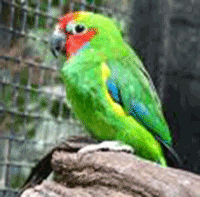 by Jim Hayward
by Jim Hayward
Opopsitta is often used instead of Cyclopsitta. Fig Parrots have also been called 'Dwarf Parrots' and 'Lorilets'.
ORIGINAL HOMELAND:
The nominate race is distributed through a large area of northern and southern parts of western New Guinea - as well as some coastal islands.
NATURAL HABITAT:
Forest and edges of forest, as well as isolated groves of trees.
STATUS IN THE WILD:
Common in its localities, moreso around the forested bases and sides of hills and mountains.
STATUS IN AVICULTURE:
An avicultural rarity; isolated consignments from Indonesia in the late 'seventies and early 'eighties have not resulted in the species becoming established.
LEVEL OF KEEPER'S EXPERIENCE:
Only the most advanced and dedicated parrot breeders should attempt to take on this difficult species - or any of the Fig Parrots for that matter.
HARDINESS:
Reported to be reasonably hardy once fully acclimatized - but who would be willing to risk a tiny bird of such delicate appearance to the rigours of a British winter?
TYPE OF ACCOMMODATION:
A birdroom with large inside flight cage/shelters attached to well protected outside flights, so that the birds may be allowed entrance to the outer aviaries and receive the benefit of sunshine and showers when the temperature is suitable.
TYPE OF DIET:
In the wild - though eating other fruits, seeds and berries - they are very specialised feeders and live mostly on the various species of small native figs, choosing the tiny seeds and generally discarding any fleshy parts. They also feed off blossoms, taking nectar and insects, will excavate and tear apart rotten wood to get at insects, larvae and grubs, and have been seen eating rotten wood, fungus and lichen attached to bark. In aviculture a wide variety of foods is essential, from small and large seeds (including millet, canary, safflower and sunflower), to a wide variety of vegetables and fruits (including figs, apple, banana, papaya, carrot, kiwi, grapes, cherries, soft and hard berries, milky corn, sweet potato, peas, germinated mung beans). Insectivorous and canary rearing food is important (with boiled egg yolk mixed in), livefood must be provided - as well as nectar. Rotten stumps of wood to gnaw appear to be an important addition to the digestive process.
SEXING:
The red on the cheeks of cocks is replaced by a buffish colour in hens; immatures lack the red cheeks and have paler bills, they take about a year to acquire full adult appearance.
SEXUAL MATURITY:
Not known, but probably mature at around a year old.
NESTING SEASON IN BRITAIN:
According to the few reported breedings in Europe, nesting has commenced in summer, with young fledging as late as early autumn.
TYPE OF NEST:
In the wild, these strong billed little parrots bore an entrance hole and excavate a shallow hollow (around 3 1/2" to 4" in diameter and depth) out of rotten trunks and branches; there is no distinction between vertical and horizontal branches and they tend to excavate subsequent nests close by the old one.
USUAL NUMBER OF EGGS:
Two.
INCUBATION PERIOD:
18 to 19 days.
USUAL NUMBER OF YOUNG:
One, sometimes two.
FLEDGING AGE:
Between five and six weeks.
USUAL NUMBER OF CLUTCHES:
Two and sometimes three nests can be attempted in succession.
NESTING HABITS:
Only the hen incubates. The work of excavation done by the hen is important for the breeding process, and success has been achieved by breeders providing un-worked rotten logs as nests.
SPECIAL CONSIDERATIONS:
Living as they do in the dense forest canopy, a large open space aviary can confuse them with the result that they can crash into the wire and frame and damage themselves.
NOISE FACTOR:
High pitched calls and chatterings.
AVAILABILITY:
Seldom - if ever - available to general aviculture in these days.
